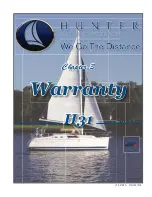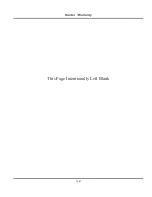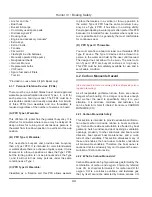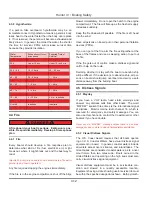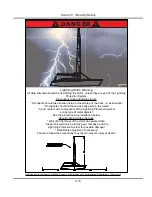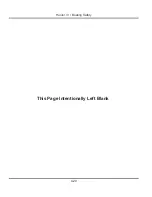
Hunter 31 • Boating Safety
4.5
diffuses in the air much more rapidly than other gasses
that are detectable by the human senses. The weight of
CO is about the same as air so it does not rise or fall like
other gasses but will distribute itself throughout the boat.
CO is produced any time a material containing carbon is
burned. In boating, these materials include, but are not
limited to, gasoline, diesel fuel, or propane. All carbon
based fuels produce varying amounts of CO, depend-
ing on their carbon content. Gasoline is high in carbon
and, therefore, produces lower levels of CO. However,
the exhaust of all engines and generators as well as any
open flame device, produce CO and the same precau-
tions should be taken regardless of the type of fuel.
4.2.3 How Carbon Monoxide Can Enter Your Boat
Any device that burns fuel creates Carbon Monoxide. For
example, a propane cook-top or a space heater are both
potential sources for CO. But the most serious danger
comes from the gasoline engines and generators aboard
your own and neighboring boats. There are four basic
ways that CO from a running engine or generator can
enter your boat.
The “station wagon effect” results from the aerodynamics
of deck cabins and flying bridges. With the boat under-
way, the air flow over the top forms a low pressure area
behind the cabin or transom which can suck exhaust gas-
ses into the cockpit and the cabin inefficient trim angles
also can cause the station wagon effect.
4.2.4 Symptoms of Carbon Monoxide Poisoning
Most important is to know the causes, study the symp-
toms, and be trained in the emergency care. This is
the best way to avoid, understand, and respond to any
Carbon Monoxide emergency:
One or more of the following symptoms can signal the
adverse effects of Carbon Monoxide accumulation. The
order of this list is generally the sequence of symptoms.
However, the number of symptoms and the order of their
appearance may change for different people.
Watering and Itching eyes
Tightness in the chest
Flushed Appearance
Ringing in the ears
Throbbing Temples
Inattentiveness Convulsions
Drowsiness
Headache
Dizziness
Vomiting
Collapse
Nausea
Fatigue
4.2.5 Effects of Carbon Monoxide
When inhaled, Carbon Monoxide is absorbed by the
lungs and reacts with the blood hemoglobin to form
carbon hemoglobin, which reduces the oxygen carrying
capacity of the blood. The result is a lack of oxygen
for the tissues, causing subsequent tissue death and, if
prolonged, death of the individual. Carbon Monoxide in
high concentrations can be fatal in a matter of minutes.
Even lower concentrations must not be ignored because
the affects of exposure to CO are cumulative and can
be just as lethal. Certain health related problems and
age increases the effects of CO. People who smoke or
are exposed to high concentrations of cigarette smoke,
consume alcohol, or have lung or heart disorders are
particularly susceptible to an increase in the effects from
CO. However, the health of all of the boat’s occupants
should be considered. Physical exertion accelerates the
rate at which the blood absorbs CO. The early effects
of CO poisoning are easy to overlook because they are
similar to the effects of other boating related stress such
as eye strain, fatigue, sun exposure, seasickness, or
alcohol consumption. But, as the concentration of CO in
the air increases, it has increasingly adverse effects on
your health.
4.2.6 When Overcome by Carbon Monoxide
When someone falls victim to Carbon Monoxide poison-
ing, fast and responsive action is crucial. Know the symp-
toms. The earlier the effects of CO are detected, the
better the chances for recovery. The following list shows
the sequences of events that must be done in an effort to
revive a CO victim:
Evacuate, Ventilate, Investigate, complete the Carbon
Monoxide poisoning action sequence
Move the victim to fresh air.
Administer oxygen if available. If the victim is not
breathing, perform artificial resuscitation per approved
CPR procedures until medical help arrives and takes
over. Prompt action can mean the difference between
life and death.
Ventilate the area.
Investigate the source of CO and take corrective
action.
•
•
•
•
•
Summary of Contents for H31
Page 1: ...Operator s Operator s Manual Manual H31 H31 V1 031507 P N 1031379 ...
Page 2: ......
Page 9: ...Introduction Introduction H31 H31 Chapter 1 Chapter 1 V1 031507 P N 1031379 ...
Page 14: ...Hunter 31 Introduction 1 6 Notes ...
Page 15: ...V1 031507 P N 1031379 and Documents Documents Forms Forms H31 H31 Chapter 2 Chapter 2 ...
Page 26: ...Hunter 31 Documents and Forms Maintenance Log Date Maintenance Performed Hourmeter 2 12 ...
Page 27: ...Hunter 31 Documents and Forms 2 13 Date Maintenance Performed Hourmeter Maintenance Log ...
Page 33: ...Hunter 31 Documents and Forms 2 19 Spare Parts List ...
Page 34: ...Hunter 31 Documents and Forms Dates of practice drills and onboard safety inspections 2 20 ...
Page 35: ...Hunter 31 Documents and Forms 2 21 My personal preferences for maintenance items safety gear ...
Page 36: ...Hunter 31 Documents and Forms Notes 2 22 ...
Page 37: ...V1 031507 P N 1031379 Warranty Warranty H31 H31 Chapter 3 Chapter 3 ...
Page 38: ...This Page Intentionally Left Blank Hunter Warranty 3 2 ...
Page 45: ...Boating Boating Safety Safety H31 H31 Chapter 4 Chapter 4 V1 031507 P N 1031379 ...
Page 64: ...This Page Intentionally Left Blank Hunter 31 Boating Safety 4 20 ...
Page 65: ...Chapter 5 Chapter 5 Fuel Fuel Systems Systems H31 H31 V1 031507 P N 1031379 ...
Page 71: ...A Quick Fuel Filter Reference Hunter 31 Fuel Systems 5 7 Fig 5 6 ...
Page 76: ...Notes Hunter 31 Fuel Systems 5 12 ...
Page 79: ...Underwater Underwater Gear Gear H31 H31 Chapter 6 Chapter 6 V1 031507 P N 1031379 ...
Page 80: ...Hunter 31 Underwater Gear 6 2 This Page Intentionally Left Blank ...
Page 89: ...Hunter 31 Underwater Gear 6 11 ...
Page 91: ...DC Electric DC Electric Systems Systems H31 H31 Chapter 7 Chapter 7 V1 031507 P N 1031379 ...
Page 100: ...Hunter 31 DC Electric 7 10 Notes ...
Page 105: ...AC Electric AC Electric Systems Systems H31 H31 Chapter 8 Chapter 8 V1 031507 P N 1031379 ...
Page 112: ...Hunter 31 AC Electric Systems 8 8 Notes ...
Page 114: ...Hunter 31 AC Electric Systems 8 10 Notes ...
Page 115: ...Water Water Systems Systems H31 H31 Chapter 9 Chapter 9 V1 031507 P N 1031379 ...
Page 122: ...Hunter 31 Water Systems 9 8 Notes ...
Page 123: ...Waste Waste Systems Systems H31 H31 Chapter 10 Chapter 10 V1 031507 P N 1031379 ...
Page 132: ...Hunter 31 10 10 Waste System Bilge Water ...
Page 134: ...Hunter 31 Waste and Sanitation Systems 10 12 Notes ...
Page 143: ...Hunter 31 11 9 Exhaust System ...
Page 144: ...Hunter 31 Engine and Transmissions 11 10 Notes ...
Page 145: ...V1 031507 P N 1031379 Sails Sails Rigging H31 H31 Chapter 12 Chapter 12 and and ...
Page 150: ...Hunter 31 Sails and Rigging 12 6 Notes ...
Page 154: ...Hunter 31 12 10 Jib Furling Line Layout ...
Page 155: ...Hunter 31 12 11 Optional Mainsheet Purchase Traveler Layout ...
Page 156: ...Hunter 31 12 12 Arch Installation ...
Page 157: ...Hunter 31 12 13 Lazyjack Installation ...
Page 158: ...Hunter 31 12 14 Optional Spinnaker Layout ...
Page 159: ...Getting Getting Underway Underway H31 H31 Chapter 13 Chapter 13 V1 031507 P N 1031379 ...
Page 166: ...Hunter 31 Getting Underway 13 8 Notes ...
Page 167: ...Maintenance H31 H31 Chapter 14 Chapter 14 V1 031507 P N 1031379 ...
Page 180: ...Hunter 31 Maintenance 8 8 Notes ...
Page 181: ...Glossary Glossary H31 H31 Chapter 15 Chapter 15 V1 031507 P N 1031379 ...



